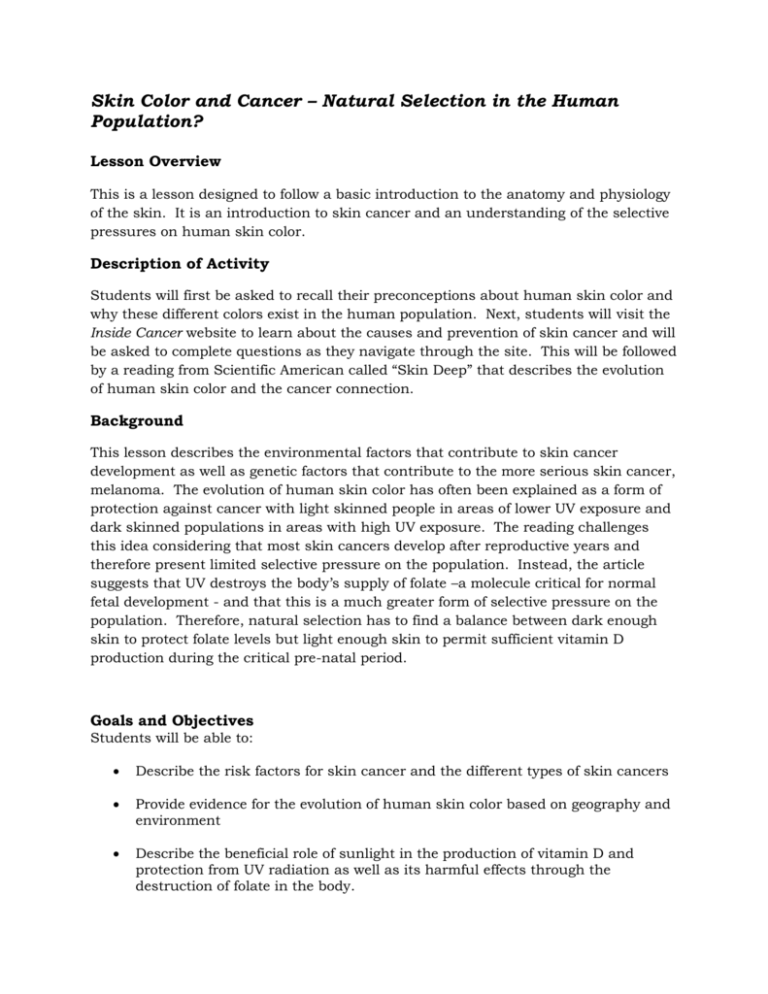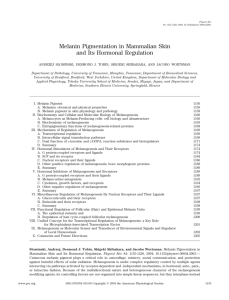Skin Color and Cancer – Natural Selection in the Human Population
advertisement

Skin Color and Cancer – Natural Selection in the Human Population? Lesson Overview This is a lesson designed to follow a basic introduction to the anatomy and physiology of the skin. It is an introduction to skin cancer and an understanding of the selective pressures on human skin color. Description of Activity Students will first be asked to recall their preconceptions about human skin color and why these different colors exist in the human population. Next, students will visit the Inside Cancer website to learn about the causes and prevention of skin cancer and will be asked to complete questions as they navigate through the site. This will be followed by a reading from Scientific American called “Skin Deep” that describes the evolution of human skin color and the cancer connection. Background This lesson describes the environmental factors that contribute to skin cancer development as well as genetic factors that contribute to the more serious skin cancer, melanoma. The evolution of human skin color has often been explained as a form of protection against cancer with light skinned people in areas of lower UV exposure and dark skinned populations in areas with high UV exposure. The reading challenges this idea considering that most skin cancers develop after reproductive years and therefore present limited selective pressure on the population. Instead, the article suggests that UV destroys the body’s supply of folate –a molecule critical for normal fetal development - and that this is a much greater form of selective pressure on the population. Therefore, natural selection has to find a balance between dark enough skin to protect folate levels but light enough skin to permit sufficient vitamin D production during the critical pre-natal period. Goals and Objectives Students will be able to: Describe the risk factors for skin cancer and the different types of skin cancers Provide evidence for the evolution of human skin color based on geography and environment Describe the beneficial role of sunlight in the production of vitamin D and protection from UV radiation as well as its harmful effects through the destruction of folate in the body. Assumptions of Prior Knowledge Students should be introduced to the basic anatomy and physiology of the skin including the epidermis, dermis, and the role of melanocytes. Common Misconceptions • • • Students may believe that skin cancers are only the result of exposure to the sun. Students may believe that the reason for differences in human skin color is best explain as a form of protection against cancer. Students may believe that ultraviolet radiation for the sun has only negative effects on the body. Implementing the Lesson Time Allotment – 10-15 minutes for pre-conceptions and quick sharing of them, 20 minutes for Inside Cancer website, 20-30 minutes in class for beginning Skin Deep reading - finish for homework. Before Class – Review anatomy & physiology of the skin, photocopy student worksheets, and check computers. During Class – If there are not enough computers, consider having half the class start on the inside cancer reading and the other half do a review activity. Recommendations for Evaluation: Essay question: Explain the evidence for the evolution of human skin color. Be sure to explain the following words in your answer: folate, vitamin D, melanin, & melanocytes. Suggestions for Extended Learning Have students research in more detail the different types of skin cancer and the characteristics of each. Glossary Cholesterol – a molecule found in cell membranes that is begins a conversion to Vitamin D in the skin with sunlight and finalized in the liver Folate – one of the B vitamins that is a key factor in the production of nucleic acids and necessary for cell growth and division Melanin – a skin pigment that protects the skin from ultraviolet radiation Melanocytes – cells in the epidermis of the skin that produce melanin pigments Melanoma – a form of skin cancer that develops in melanocytes and may become malignant Squamous cell carcinoma – a skin cancer of the cells of the epidermis, or outermost layer of the skin Vitamin D – a steroid vitamin that permits intestinal absorption of calcium and phosphorus; synthesized in the skin or consumed in the diet Resources 1. Inside Cancer Website: www.insidecancer.org - Causes & Prevention “Sunlight” 2. Article: Skin Deep -By Nina G. Jablonski and George Chaplin; Scientific American, October 2002 Available to purchase at http://www.scientificamerican.com/article.cfm?id=skin-deep Name __________________________________________________ Period _______ Date ________ Skin Color and Cancer – Natural Selection in the Human Population? Investigative Question: What do you notice about the differences in human skin color? How are these differences advantageous (beneficial) to the population? Write your initial ideas here: Part I. Inside Cancer Directions: Go to www.insidecancer.org and click on the Causes and Prevention tab and click on “Sunlight.” Navigate through this section of the website to answer the following questions. Sunlight 1. What are some skin cancers like squamous cell carcinoma directly attributed to? 2. How is melanoma different than squamous cell carcinoma in terms of the cause? 3. Using the map of Italy below, circle in the varying degrees of UV exposure and the average skin colors. UV Exposure (circle one): Low Medium High Average Skin color (circle one): Light Average Dark UV Exposure (circle one): Low Medium High Average Skin color (circle one): Light Average Dark 4. What would we expect the incidence rate of cancer in Ireland to be like and why? 5. How does the actual incidence rate of Ireland compare to that of the US? 6. Why do you suppose this is? 7. How do the rates in Australia compare to the rates in the U.S.? 8. What factors can account for some of this difference? Part II. Skin Deep – Scientific American - October, 2002 Please complete the following in your journal using complete sentences. 1. Research Findings As you read through this article take notes on the actual findings from studies. Write them in your journal in complete sentences. Try to pull out items that are more specific rather than what I’m asking for in #3. 2. Global Evolution of Skin Color. Make a simple sketch of the globe and shade in the historical patterns of skin color. Be sure to include the exception(s) to the general trend and be able to explain why these are exceptions. 3. Explanation Paragraph Write a full paragraph (4-8 sentences) describing the connection(s) between the following words: skin color, melanin, vitamin D, folate*, UVR, DNA, cholesterol*. Be sure to explain the functions of these words. Underline them in your own paragraph. (*Look closely for these two – many people often miss this!) 4. My Response Please include 3-4 sentences of your thoughts and reactions to this article. What was something you learned that you did not know before? What other questions does this bring up for you? How does this relate to you? INSIDE CANCER – TEACHER ANSWER KEY Sunlight 1. What are some skin cancers like squamous cell carcinoma directly attributed to? Exposure and damage from UV-B radiation from sunlight 2. How is melanoma different than squamous cell carcinoma? There are genetic factors that play a role 3. Using the map of Italy below, circle in the varying degrees of UV exposure and the average skin colors. UV Exposure (circle one): Low Medium High Average Skin color (circle one): Light Average Dark UV Exposure (circle one): Low Medium High Average Skin color (circle one): Light Average Dark 4. What would we expect the incidence rate of cancer in Ireland to be like and why? High because the people living there are mostly fair skinned. 5. How does the actual incidence rate of Ireland compare to that of the US? Ireland has only about 1/3 the cases 6. Why do you suppose this is? Maybe because they have lower levels of UV exposure and maybe because they avoid sun exposure more than North Americans. 7. How do the rates in Australia compare to the rates in the U.S.? They are 3x higher in Australia 8. What factors can account for some of this difference? There are more light skinned people in Australia







